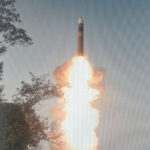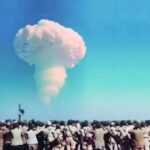Questioning the case for new nuclear weapons
By Adam Mount | August 21, 2015
Recent developments—Russian aggression in Ukraine, China’s expanding territorial claims, and the need to modernize the US nuclear arsenal—have caused scholars to revisit a labyrinthine world of nuclear strategy largely neglected since the end of the Cold War. But this new wave of theory has resurrected some dubious arguments. In recent months, a number of strategists have argued that the United States needs to develop a new generation of low-yield nuclear warheads to deter its adversaries from a particular scenario of nuclear escalation. Under this concept, a US adversary could employ a small nuclear warhead in an attempt to force the United States to back down from a crisis. Though such a possibility is a serious concern, looking closely at the strategic calculus of nuclear retaliation shows that it is not a reason to develop and forward-deploy new nuclear weapons.
This new concept for nuclear weapons use follows from the principal feature of international security today: With sufficient time and preparation, the United States can apply overwhelming conventional military superiority against any actor on the face of the Earth. This has changed how other countries think about the role of nuclear weapons in their national defense. Today, there are signs that US adversaries, especially Russia, plan to employ nuclear weapons to truncate any escalating conflict with the United States. In a recent article in Survival, I refer to this concept of nuclear use as “offset escalation:” An enemy hopes to offset US conventional superiority by escalating to the nuclear level. Because this is the likeliest scenario for nuclear use today, the question of how to deter or avoid it is a key challenge for defense strategists. For example, the 2014 Quadrennial Defense Review argues that a primary mission of the US nuclear deterrent is to ensure that adversaries “cannot escalate their way out of failed conventional aggression”—or, to phrase it another way, to make sure that US adversaries can’t cover their crimes with their nuclear arsenal.
Elbridge Colby, the Robert M. Gates Senior Fellow at the Center for a New American Security, has been instrumental in sounding the warning about the possibility of offset escalation. For Colby and others, offset escalation is made more likely by the structure of the US nuclear arsenal. An arsenal designed for massive retaliation against a Soviet first strike lacks the “discrimination and flexibility” necessary to deter the kinds of lower-yield, electromagnetic pulse, or nonlethal strikes that an adversary might employ to force the United States to back away from a gathering conflict. To fill the gap, Colby argues, “the United States should develop capabilities, options, and doctrine to enable limited and tailored nuclear strikes—including with varying yields, trajectories, and target types…”—in short, the “capabilities needed to fight a limited nuclear war more effectively than plausible adversaries.”
There is much to recommend Colby’s argument. It is incumbent upon all civilian and military officials to ensure that any operation is discriminate and proportional to the original attack; flexibility is a desirable property of any inventory of weapons systems—especially one that can be reconfigured only rarely. It is intuitive and plausible that like weapons are needed to deter a limited offset escalation strike.
However, the US government needs better evidence before it shifts nuclear strategy in potentially destabilizing ways. In the Survival article, I explain the strategic logic of nuclear restraint: If deterrence fails and a US adversary employs a nuclear weapon, the United States has strong reasons to refrain from nuclear retaliation. Prevailing in the conflict at hand, projecting an image that will serve US interests in future conflicts, and creating a stable world over the long run may require Washington to instead press a conventional response. In some circumstances—against a powerful adversary, for example, or in the case of a highly destructive first strike—the case for nuclear restraint may be outweighed by other considerations.
But a close look at hypothetical scenarios of nuclear use suggests that the costs of nuclear retaliation would be even higher in response to cases of offset escalation. As a result, concerns about offset escalation make conventional responses relatively more appealing and nuclear retaliation relatively less so.
For example, it would almost certainly not be in the American interest to reciprocate a nonlethal nuclear blast. An adversary like Russia or China could detonate a nuclear weapon high over a regional battlefield, generating an electromagnetic pulse that damaged electrical equipment but did not produce casualties from its blast effects. If the United States were to respond in kind, this exchange of demonstration strikes would harm the global nonproliferation regime, signal other states that they could provoke a nuclear reaction at will, and dilute the global opprobrium the attacker would face for using a nuclear weapon first. At the same time, in-kind retaliation would do little to dissuade the adversary from continued nuclear use, nor would it ensure a favorable resolution of the crisis. These considerations cast serious doubt on the need to develop “special effects” weapons like ones optimized to produce an electromagnetic pulse. It is not at all clear that possession of such a warhead would deter an adversary from employing one.
The question of how to respond to a low-yield but lethal nuclear strike is more complex. For example, if North Korea detonated a small nuclear weapon at a location chosen to produce limited military casualties and few civilian ones, the pressure to respond in kind might be great. However, many of the costs the United States would incur from employing a nuclear weapon would still apply, regardless of the yield. Certainly, international opprobrium would be greater following a highly destructive strike, but even a lower-yield blast would generate massive disapproval and damage America’s standing as a member of the international community.
In other ways, if the United States employed a new, low-yield nuclear warhead, it could suffer greater costs than it would, if the response involved existing, nonnuclear weapons. A lethal low-yield strike would erode the nuclear taboo at least as much as a larger-yield blast. Such a strike would stand as a moral statement that the United States believed using low-yield nuclear weapons was a legitimate instrument of escalation control. Shattering the nuclear taboo would lead to significantly higher proliferation pressures—on non-nuclear states to launch new programs to build “usable” systems, and on existing nuclear states to update their arsenals to reflect this new reality. It is far safer to maintain that nuclear weapons are not an effective means of controlling escalation, for both the United States and its adversaries.
While proponents of the new, smaller warheads will assert that the US president should have every possible option available in a crisis, the simple fact is that this is not how military planning works. US policymakers would be hesitant to spend money on weapons that are less likely to be useful when there are several large conventional procurement programs for systems that are likely to be useful. As military budgets tighten, it will become more and more important to reject categorical and limitless statements like “we must provide a president with every possible option.”
The costs of building any new nuclear weapons—including low-yield warheads—are not only monetary. A new warhead program would accelerate foreign modernization efforts, increase proliferation pressures, damage the nonproliferation regime, and shatter the nuclear taboo. In short, the cost of building new nuclear weapons not only crowds conventional defense programs; it also distracts from other national priorities, and potentially erodes international security.
Proponents of the new weapons will hasten to point out that we don’t build nuclear weapons with the intention of using them; we build them so that they need not be used—that is, for deterrence. Why, then, should low-yield weapons be subject to different standards?
It is a fair question, but it shifts the tenor of the conversation from the need to build weapons that the United States must have for specific employment scenarios, to the capabilities necessary to maintain deterrence. This in turn shifts the burden of proof to the proponents of new systems. Before, they could rightly claim that opponents of low-yield weapons needed to provide an alternative theory for how to deter offset escalation. But, adding the costs of employing a low yield weapon to the equation raises more pressing questions. For instance: If the use of a low-yield nuclear weapon is not in the American interest, will these weapons’ marginal advantage as credible deterrents really be decisive in shifting an adversary’s calculation about first use? In other words, how confident should we be that a low-yield weapon will suffice to deter an offset escalation strike, where a larger one would not?
Furthermore, the strategic logic of nuclear restraint suggests that conventional deterrence, properly calibrated, may outperform nuclear deterrence as a means of preventing offset escalation. If there is reason to believe that a conventional response will lead to a better resolution of some crises, why should the threat of conventional attack be less effective at deterring the strike in the first place? Are there steps that US policymakers can take to better communicate the devastating consequences of conventional war? Certainly, the tendency in Washington to denigrate the effectiveness of conventional deterrence (like, for instance, many arguments in favor of building low-yield nuclear weapons) decreases its efficacy as a tool of statecraft.
Though much has changed since the end of the Cold War, the effectiveness of a nation’s nuclear deterrent still depends on the credibility of the threat to use those weapons. While the threat to employ a low-yield weapon has greater credibility because it risks fewer casualties, this is not the only consideration that matters. The use of any nuclear weapon will have negative effects that resonate through the international system, and many of these broader costs are indifferent to the yield of the warhead. In other ways, the production and use of a low-yield warhead will incur greater costs than continued reliance on existing US weaponry.
The case for sub-kiloton, low-yield, and special effects weapons depends on them being more usable than high-yield weapons, but the credibility of a nuclear threat depends substantially on whether it would be in the national interest to carry out that strike. There is good reason to doubt that it would be in the US national interest to use a low-yield nuclear weapon, especially in cases in which an enemy hopes to offset US conventional superiority by escalating to the nuclear level. If there is a case to be made for building new, low-yield nuclear weapons, it won’t be convincing unless it accounts for all the costs of employing them. As the debate unfolds, strategists should not assume that the possibility of offset escalation is a reason to develop new warheads. It may be a better reason not to.
Together, we make the world safer.
The Bulletin elevates expert voices above the noise. But as an independent nonprofit organization, our operations depend on the support of readers like you. Help us continue to deliver quality journalism that holds leaders accountable. Your support of our work at any level is important. In return, we promise our coverage will be understandable, influential, vigilant, solution-oriented, and fair-minded. Together we can make a difference.
Topics: Nuclear Weapons, Opinion















